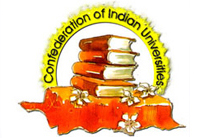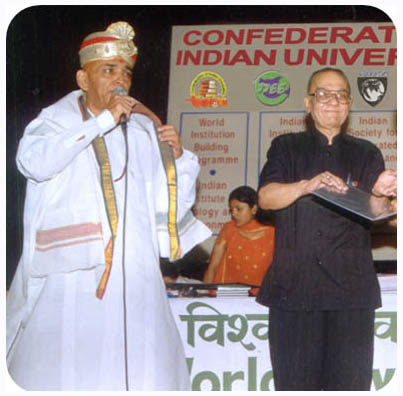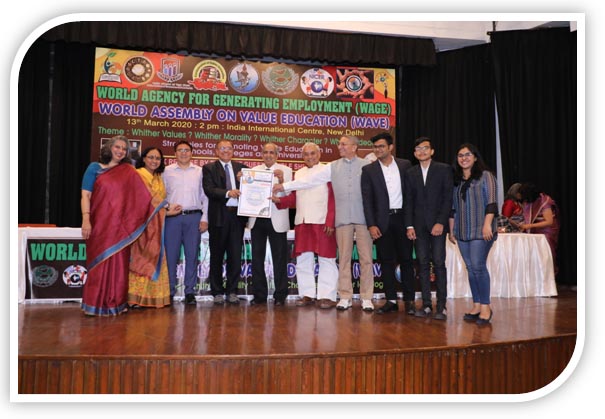About Confederation of Indian Universities (CIU)

Born on 21st April, 2004, CIU is an apex body of universities in
India, with around 1200 universities as its member. It is a
purely voluntary organization of universities and university
level institutions in India. It provides various kinds of
services to its member organization, services such as
opportunities to collaborate with leading international
institutions, curriculum enhancement consultancy, pedagogy
development consultancy, consultancy on quality enhancement,
research guidance & facilitation, publishing opportunities for
scholars, dissemination of information about available
opportunities in national and international academic
institutions, consultancy on legal matters such as handling of
relationship with statutory bodies etc.
CIU does not look at academia as an insulated universe. Instead,
we at CIU believe that universities are parts of larger social
system, from where they draw various kinds of nourishment such
as finance, manpower, market etc. Thus, according to CIU,
universities owe it to society to contribute towards development
of a better and smarter society. In a way, CIU is not just about
the universities themselves, as it is about the relationship
that exists between the universities and the society at large.
CIU believes that it is its solemn duty to nourish this
relationship and help sustain the symbiosis that is the
foundation of this relationship.
There are of course other platforms where universities
congregate. But, most of the times, either those platforms are
simply avenues for the Government to interact with the top
management of the university system, or, those are voluntary
associations designed to act as advocacy platforms, platforms
through which universities mostly lobby for better tax
environment, lesser compliance burden, freedom to raise funds
etc.
CIU however, as described above, is different. It is not just a
platform for universities to improve their collective bargaining
strength, but, more importantly, it is a platform where all
stakeholders, namely civil society, Government, corporate world,
independent scholars, media and NGOs come together with the sole
purpose of finding out ways & means to improve the functioning
of the relationship that exists between universities and society
at large.
Origins & leitmotif of CIU:
Those who are familiar with the history of expansion of
educational infrastructure in post-independence India, know that
for a large part of the time since 1947, almost every single
institution in the country survived largely by adopting a
submissive, non-intrusive and apolitical posture in its
interactions with the State machinery. Education too was no
different.
There was a time, not in some remote, hidden corner of our
history, but quite literally, out in the open, when educational
institutions at all levels, beginning with primary schools and
all the way up to universities, had to bow down to an inspector
raj system. It was basically a system which allowed civil
bureaucracy a decisive hand in the formation and management of
educational institutions. It was very much in tune with the
workings of a centralized, statist model that had been adopted
by India as her Governance model at the time of her
independence.
Such a model of Governance had a devastating warping effect on
the nature of institutions in our country. As a result, crucial
sectors of our national life such as industry & commerce,
agriculture, healthcare, infrastructure, law & order, justice
delivery, crucial democratic functions like impartial management
and conducting of electoral process, and delivery of almost all
other Government services to the citizenry took multiple
crippling blows during this period. Education sector too
suffered in such an atmosphere of all pervasive Government
high-handedness.
This is not to say that it was just a saga of doom and despair.
On the contrary, many of the finest academic institutions of our
country were born and nurtured during those times. Institutions
like IITs, IIMs, IISc, RECs, later rechristened NITs etc were
shining examples of this. But, ultimately, at the end of the
day, progress made has to be evaluated against parameters such
as results obtained vs results expected, investment made vs
output obtained, whether the pouring of massive public
investments generated enough returns to cover the opportunity
costs etc. When such an exercise was conducted for our education
system, one had to concede that the results achieved were often
way short of the expectations.
But, as happens in case of any overly centralized endeavour,
this system, even though festooned with multiple cracks in its
structural integrity, was loathe to admit its failings and was
not ready to loosen its status as the post-colonial overlord of
India. As a result, Government machinery found itself
overstretched to a point of almost cracking open. Moreover,
unfortunately for the Governing class, as the spirit of
democracy started striking roots in India, people of India,
especially the middle class, in spite of Government attempts to
muzzle its spirits, started demanding accountability.
What compounded the agony for the Government was the financial
crunch that soon engulfed the whole system. In the fiscal
disaster created by the ‘Hindu rate of growth’ that the
Nehruvian model was generating, it was no longer possible for
the Government to endlessly pour money into endeavours that were
not adding value to the system. Soon, the Government had to
agree to provide lion’s share of limited budgetary capacity to
issues with greater electoral heft. Issues like rural
development, welfare measures such as public distribution
system, management & funding of vast and burgeoning system of
reservations etc soon outcompeted the education sector when it
came to access to public financing. It was in this kind of
scenario when Government machinery started ceding space to the
concept of professionally run institutions.
From the point of view of educational institutions, end of the
era of all-pervasive Government overlordship had some positive
and a few negative consequences. On the plus side, this phase of
withdrawal of the Government, primarily meant two things, namely
more autonomy to educational institutions, especially
universities and university level institutions and greater space
for private sector within the educational landscape of the
country.
On the minus side, withdrawal of the Government also meant
faster than expected disappearance of the system of generous
Government financing that was previously available to the
Government institutions. One might say that this was a problem
limited to the Government owned institutions. But, when such
institutions constitute almost the entirety of the system, from
being a sectoral one, the problems soon assume systemic
proportions. Sadly, for the Government machinery, the situation
of the public finances, instead of improving, kept on
deteriorating. The terrible financial crunch meant that the
Government became more and more reticent when it came to taking
capital decisions for sectors that were not likely to result in
additional tax revenues, at least in the short to medium term.
This reluctance of the Government meant that most of the
existing publicly funded institutions were increasingly looking
at ever tightening financial constriction. Investments in
research and in capital intensive projects such as creation of
additional capacity soon became quite scarce. On the other hand,
due to factors emanating from demography, the demand for good
quality education was rising rapidly at all levels.
This matrix of high demand and limited supply, created northward
pressure on price of highly-in-demand courses such as medicine,
engineering, management and any other stream that promised a
good future for the students pursuing them. This naturally
created powerful incentives for private capital to enter the
education space.
But, unfortunately, most of the private players that entered the
education space between 1990s and the entire first decade of the
21st century, came with the mindset of reaping big and quick
rewards. They did not have any serious commitment to the cause
of education.
Therefore, education, especially the higher education space,
became saturated with players with dodgy intentions. The
interests of the country, and of the students, were therefore
never really paid adequate attention to. So, outwardly, at least
in a statistical sense, India was posting impressive growth in
the expansion of its educational infrastructure. But, in
reality, the scene was largely chaotic, wasteful, inefficient
and rapacious.
Reports after reports, from Government as well as independent
sources, were raising loud alarms about the falling standards in
our academia. Commentators, especially those with a corporate
background such as Gurcharan Das, Mohan Das Pai etc were
repeatedly warning that any sustained degeneration of Indian
education system, if not properly addressed, was a bad omen for
Indian economy and therefore for India too. Even professional
academicians like Jean Dreze etc were also saying more or less
the same things.
This was also the period when the country was being pounded by
dangerous churnings in society like rising caste tensions,
increasingly fragile communal amity, domestic industry running
the risk of being swamped by global MNCs, and an overall decline
in institutional capacity. That was the time when the country
needed its intelligentsia to properly study what was going on,
synthesize the multiple variables and create a holistic model
that could restore the socio-economic equilibrium and put the
country solidly on the path of domestic peace and global
expansion in terms of our economic footprint.
But, in reality, what the country got was massive
disappointment. By the time the crisis started maturing, our
academia had lost the capacity to productively reflect on issues
and come out with solutions. Things that were being bandied as
solutions, were in fact, rearticulations of what was already
known. It was therefore clear that the country needed a bold new
approach towards education and academia.
Various individuals and institutions came forward to answer this
national call. Among them, CIU is counted as one of the most
respectable names. Although the institution was formally born in
2004, it had been brewing in the minds of some of the most
eminent educationists of India such as Prof. K.
Venkatasubramanian, former Member of the Planning Commission,
Government of India and Dr. Priya Ranjan Trivedi, noted
educational evangelist of India. It was largely through the
efforts of people like Dr. Venkatasubramanian and Dr. Trivedi
that renowned minds were pooled in to lay the foundation of CIU.
As of now, CIU is engaged in multiple projects largely aimed at
fulfilling the role that its founders envisaged for it. The
spectrum of CIU’s activities include research, translation of
acclaimed books from global languages into Indian ones &
vice-versa, launching of high value courses in India in
collaboration with international academic institutions, advocacy
for better policy regimes and above all, widening of emotional
and intellectual horizon of anyone who comes in contact with
it..
Note on Confidentiality
It is a property of Inter-University Research Centre (IURC)
which is a platform floated by Confederation of Indian Universities (CIU), an
apex body of around 1200 universities and university level institutions in
India.
The information in this website are meant for the exclusive consumption of
people associated with CIU and IURC. If anyone else happens to find this
document or any part thereof, the person is requested to immediately get in
touch with the office of either CIU or IURC and return the document to our any
of our officers.
Unauthorized accessing, publication, whether in part or in full, or sharing &
distribution of the contents of this document without the prior approval of IURC,
is an offence. The same, if brought to the notice of IURC or CIU, would be
considered an infringement of our intellectual property, and the organization
would consider itself free to pursue appropriate legal action..
Purpose of this Information
This document is not a scholarly writing on the topic of
human induced climate change. It is a document that has been prepared with the
intention of introducing the idea called Inter-University Research Centre (IURC)
which has been floated recently by Confederation of Indian Universities (CIU).
Through this document, an attempt has been made to explain what CIU is and what
it does. This document also explains what IURC is and what its relationship with
CIU is. This document also contains brief introduction about all that IURC
intends to pursue in near future, including what it plans to do for the cause of
climate preservation.
Finally, this document should be seen as a call to collaboration, going out from
one organization in India to all other like-minded people and organizations all
over the world..
.
Effects of Climate Change





